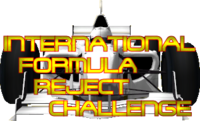AutoReject 3.5
| AutoReject 3.5 | |
|---|---|
| [[{{{logo}}}|200px]] | |
| Category | {{{category}}} |
| Country/Region | {{{locale}}} |
| Founder(s) | {{{founder}}} |
| Inaugural Season | 2016 |
| Last season | N/A |
| Engine supplier(s) | Cosworth |
| Tyre supplier(s) | Nokian Tyres |
| Records | |
AutoReject 3.5, shortened as AR 3.5 and previously named as International Formula Reject Challenge (IFRC), is a motor racing series aimed to be an alternative feeder category to F1RWRS. Compared to F2RWRS and F3RWRS, it has more relaxed driver requirements, an unique three-race format that ensures every car will start at least one race during a weekend and a more varied calendar with only a couple of events taking place on the same venues as the three RWRS categories.
History
IFRC started as a replacement to Rejects of LFS, which was put to an end by the death of Nobushige Fukuda at the 2015 Kyoto Ring round, the first such event caused directly by an on-track incident in an RWRS-sanctioned series. RoLFS had long suffered from serious safety issues, but the fatality was the final nail in the series' coffin and set forth a process that ultimately led to the announcement of IFRC.
Most of the former RoLFS teams joined the new series, along with many new entrants as the entry list was expanded from 30 to 42 entrants. None of the tracks used in RoLFS were deemed to fit the stricter safety requirements, so instead the series went to more recognized international venues. The troublesome Scaven chassis was abandoned as well, and Lola FN06 - incidentally the same chassis RoLFS's predecessor IRDU had intended to use before the organization folded - was chosen as the spec chassis. Judd and Zytek were joined by Cosworth as the third engine supplier. Terry Hawkin would win the inaugural drivers' title, while Lavezzi IBR were crowned the teams' champions.
For the 2017 season, the series was rebranded to AutoReject 3.5, following lawsuit threats from a charity foundation also using the IFRC abbreviation, and increased co-operation with the F1 Rejects Development Series which was rebranded to AutoReject 2.0 at the same time. Many rule changes were introduced to block loopholes and promote the series' status in the motorsport world, and the series moved to a fully single-make formula with only one engine manufacturer: Cosworth. Although the season was shortened to 10 weekends from previous year's 12, the championship fight was intense and lasted until the very end of the season as Bastiaan van Nieuwenhuijzen and Marko Jantscher both finished the season on the same amount of points, with van Nieuwenhuijzen being crowned the champion through countback. Falik Arrows were the teams' champions.
During the 2017-2018 off-season F1RWRS lost their court case with FIA over the use of "Formula 1" in their name, forcing them to rebrand the entire series. At the same time they also lost their official feeder series F2RWRS and F3RWRS, both of which had seen a recent change in management and been given a better financial deal by FIA to support Formula One. With little options remaining the management of F1RWRS turned to AutoReject International - who had lost control over their touring car series - and agreed to start a co-operation with them, rebranding the series as AutoReject World Series (ARWS) while AutoReject 3.5 and AutoReject 2.0 would become its official feeder categories, effective from the 2018 season onwards.
Race format
At each event, two semifinal heats of 21 cars each are run, with the top 14 from each heat making up the 28 cars that will take part in the final. The participants in each heat are determined by car numbers: cars with odd numbers race in Heat 1, while cars with even numbers race in Heat 2. If less than 14 cars finish in a heat race, then more finishers from the other heat are accepted into the final. If the combined total is still less than 28, then the cars that completed the furthest distance qualify as well. The total length of a semifinal heat is approximately 100 kilometers, while the final is 175 kilometers.
Points system
In 2016, the 2003-2009 Formula One system (10-8-6-5-4-3-2-1) was used in the heat races, with a bonus point for the fastest lap in both heats. The feature races in 2016 used a more unique 15-12-9-7-6-5-4-3-2-1 system which saw the top 10 drivers score points; a bonus point is handed for both the pole position and fastest lap.
For the 2017 season the points system was slightly altered, with the pole position of each heat being awarded with a point as well. In the feature final, the system was modified to 20-14-10-8-6-5-4-3-2-1 to make it more important than the heats; pole position and fastest lap were now worth two points each.
Technical specifications
Unlike in RoLFS, the teams are no longer permitted to individually upgrade the performance of either the chassis nor the engine. Any possible changes to the spec car are decided by the IFRC Commission.
2016: IFRC-01 and IFRC-01B
- Chassis: Lola FN06 (B06/51)
- Engine: 3000cc V8 manufactured by Judd, Cosworth or Zytek, 570/560/550 hp at 8500 rpm
- Gearbox: 6-speed paddle shift
- Bodywork: Carbon bodyshell with strengthened safety structure
- Weight: 594 kg (dry weight)
2017-18: AR35 Type 01
- Chassis: Lola FN06 (B06/51)
- Engine: 3500cc V8 manufactured by Cosworth, 560 hp at 8500 rpm
- Gearbox: 6-speed paddle shift
- Bodywork: Carbon bodyshell with strengthened safety structure
- Weight: 580 kg (dry weight)
Champions
Drivers' Champions
| Season | Driver | Team | Wins | Podiums | Points |
|---|---|---|---|---|---|
| 2016 | 6 | 15 | 163 | ||
| 2017 | 8 | 12 | 168 |
Teams' Champions
| Season | Team | Drivers | Wins | Podiums | Points |
|---|---|---|---|---|---|
| 2016 | 11 | 17 | 222 | ||
| 2017 | 8 | 17 | 253 |
